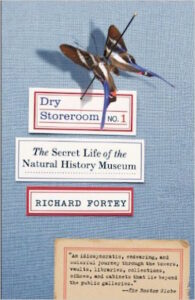Prior to reading Richard Fortey’s Dry Storeroom No. 1: The Secret Life of the Natural History Museum, I honestly cannot recall audibly exclaiming “Bravo!” upon completing a reading of any book. Such is the effect of Professor Fortey’s prose – it wraps one up in a continuous flow of fascinating scientific insights, superbly wrought historical vignettes, and exceptionally human biographical portraits such that upon completing it the first emotion that one feels is the wish for it not to have come to an end.
With a style that is at once both learned and familiar, Professor Fortey leads the reader not only through the public galleries of the London’s magnificent Natural History Museum but back into the labyrinth of unseen passages, scholars’ chambers, research labs, storerooms, and other hidden places. Along the way, not only are the various areas of research undertaken by museum staff, both past and present, discussed, but a generous amount of legend and lore are also disclosed such as would only be known to someone who has spent an entire professional life as a member of the museum’s scientific staff – and be assured, not all of it is of an entirely scientific nature (wink, wink).
Originally part of the British Museum, the Natural History Museum was separated from the “BM” in 1963 but retained its former name, the British Museum (Natural History), until 1992. However despite the additions of many modern facilities, such as the Darwin Centre (the benefits of which as well as the down-sides Professor Fortey waxes eloquently philosophic), like many great British institutions, it still retains some attributes of its earlier days – for example, its quintessentially Victorian displays of mounted specimens displayed in antique wooden and glass cases in the Bird Gallery – that give it an irreproducible charm that one devoutly hopes it never loses.
Yet make no mistake, just as the Natural History Museum is not a place stuck inextricably in the past, neither is this book a lament of the fact that “they just don’t do things the way they used to do.” To be sure, the changes seen in the Natural History Museum throughout its existence have been a mixture of the good and the bad – sometimes occurring simultaneously. Professor Fortey delves deeply into many of these changes and explains them both in light of what they were intended to do as well as the results they actually had, allowing and even encouraging the reader to make up his or her own mind as to how the museum and its work were affected.
While books have been previously written that chronicle the history and activity of museums, including the Natural History Museum itself, they have generally kept to the doings of those at the top of the administrative hierarchy, recounting which administrator enacted what initiative. Professor Fortey chose rather to spend far more time discussing and interpreting the significance of the work and contributions to science of the various specialists who do everything from collect the specimens, classify the species, and prepare the exhibits. Because of this choice, Dry Storeroom No. 1 is a far more interesting book that would have been one solely dedicated to administrators and edicts; it makes the museum, its purposes, and the people who make it what it is a more humane and human institution, and as a result far more readily understood as one without which we would be much diminished indeed.
 Title: Dry Storeroom No. 1: The Secret Life of the Natural History Museum
Title: Dry Storeroom No. 1: The Secret Life of the Natural History Museum
Author: Richard Fortey, FRS
Publisher: Knopf
Format: Hardcover
ISBN: 978-0-307-26362-9
In accordance with Federal Trade Commission 16 CFR Part 255, it is disclosed that the copy of the book read in order to produce this review was purchased by the reviewer.
